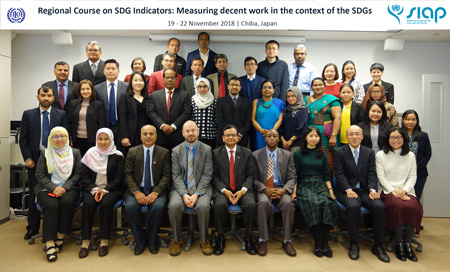
Regional Course on SDG Indicators: Measuring decent work in the context of the SDGs
19 - 22 November 2018 | Chiba, Japan
Objectives
The main objective of the Course is to better equip and situate national and international stakeholders in the new SDGs statistical monitoring system. It is designed to enhance institutional capacity to identify, collect, analyse and disseminate labour market information and other indicators related to decent work. It emphasises the 19th ICLS resolution on statistics of work, employment and labour underutilization as an important pillar of the new SDG indicator framework, not only for targets in Goal 8 but also in other Goals related to the decent work agenda.

| Materials | |
|---|---|
| Tier Classification for Global SDG Indicators | |
| S1_2: Decent work in the 2030 Development Agenda; SDGs decent work indicators | |
| S1_3: Conceptual Framework for Work statistics from the 19th ICLS Resolution: employment, labour force and labour underutilization | |
| S1_4 : SDG Labor market indicators: SDGs Goal 8: Unemployment (8.5.2); Youth NEET (8.6.1) | |
| S2_1: Introduction to STATA | |
| S2_2: Statistics on the informal employment & employment in the informal sector: Summary concepts, questions, and derived variables | |
| S3_1: Current conceptual framework of statistics on child labour | |
| S3_2: SDGs Goal 8: Earnings statistics for SDG indicator 8.5.1 | |
| S4_1: Other Tier I & II Indicators (SDGs Goals 5, 8, 10): Women in managerial positions (5.5.2), Labour share of GDP (10.4.1) | |
Country plans for SDGs DWI data production, updates in labour statistics systems | |
| Bangladesh | |
| Brunei Darussalam | |
| China | |
| India | |
| Indonesia | |
| Lao People's Democratic Republic | |
| Malaysia | |
| Mongolia | |
| Myanmar | |
| Nepal | |
| Pakistan | |
| Philippines | |
| Sri Lanka | |
| Sri Lanka (Labour) | |
| Thailand | |
| Viet Nam | |
| ASEAN | |
